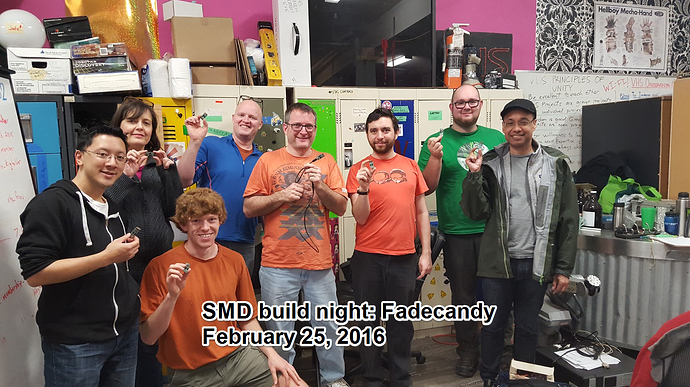I just did some reading up on the Fadecandy, because I wasn’t sure what made it special, and why I’d want to use it rather than a Teensy or something.
tl;dr Fadecandy is an LED driver board for your PC that makes the LEDs animate more smoothly, without any extra effort on your part.
Here’s what I found:
Fadecandy can be thought of as a WS2811/2812 driver board for displaying data from a PC. It doesn’t display anything on its own, and although you could certainly reprogram it with the Arduino IDE to do whatever you want, that’s not the intended use. You’re not writing your visualization algorithms in Arduino code to run on a microcontroller; instead, you write them to run on your PC (or mac, or raspberry pi) in C++, Processing, Javascript, Java, Perl, Python, etc.
What does fadecandy do, then? It receives visual frames sent over USB to be displayed, and applies automatic interpolation between frames (it interpolates pixel colours, doesn’t infer movement or anything crazy like that), high precision colour correction, and temporal dithering (flashing two adjacent colours to get the perception of an in-between colour). The combination of these features is meant to improve colour accuracy, dynamic range, and animation smoothness.
What is the hardware? It’s essentially a Teensy 3.0 (same microcontroller (MK20DX128)) plus the OctoWS2811 shield (same level converter chip (74HCT245) to output 5V signal).
Max LEDs: 64 LEDs per string (x8 = 512 total) (note that the LED wall at VHS is 8x8x3x4 = 768 LEDs)
For more LEDs, get a USB hub and more fadecandy boards.
5V power supply is required to power the LED strip; limitation of USB (might get away without one if using <10 LEDs, not sure).
Data is pushed over USB. AFAIK, there is no UART bypass or anything like that. It’s for use with a computer.
Good references and overviews:
https://github.com/scanlime/fadecandy
